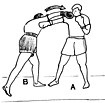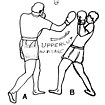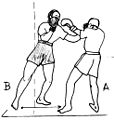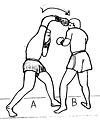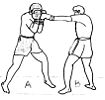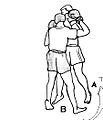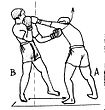
Boxing is a combat sport and a martial art in which two people, usually wearing protective gloves and other protective equipment such as hand wraps and mouthguards, throw punches at each other for a predetermined amount of time in a boxing ring.

Muay Thai, sometimes referred to as Thai boxing, is a Thai martial art and full-contact combat sport that uses stand-up striking, sweeps, and various clinching techniques. This discipline is known as the "Art of eight limbs", as it is characterised by the combined use of fists, elbows, knees and shins. Muay Thai became widespread internationally in the late 20th to 21st century, when Westernised practitioners from Thailand began competing in kickboxing and mixed-rules matches as well as matches under Muay Thai rules around the world. The professional league is governed by The Professional Boxing Association of Thailand (P.A.T.), sanctioned by The Sports Authority of Thailand (S.A.T.).
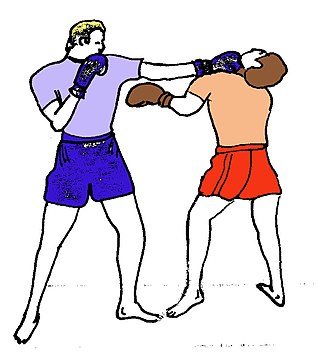
A jab is a type of punch used in martial arts. Several variations of the jab exist, but every jab shares these characteristics: while in a fighting stance, the lead fist is thrown straight ahead and the arm is fully extended from the side of the torso. This process also involves a quick turn of the torso. It is an overhand punch; at the moment of impact, the pronated fist is generally held in a horizontal orientation with the palm facing the ground.
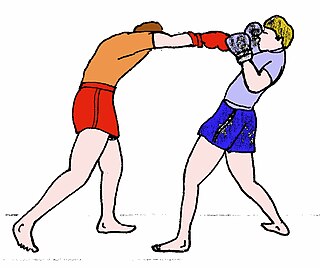
In boxing, a straight or cross are punches usually thrown with the dominant hand and are power punches like the uppercut and hook. Compubox, a computerized punch scoring system, counts the straight and cross as power punches.

A bolo punch is a punch used in martial arts. The bolo punch is not among the traditional boxing punches.

Boxing Legends of the Ring is a boxing video game for the Mega Drive/Genesis and Super NES consoles. The boxers are represented by 2D sprites seen from over the shoulder of one of the fighters. The title of the game refers to the famous boxing magazine, The Ring, which the game is licensed to associate itself with. The following famous middleweight boxers are represented in the game: Sugar Ray Leonard, Roberto Durán, Thomas Hearns, James Toney, Marvin Hagler, Jake LaMotta, Sugar Ray Robinson, and Rocky Graziano.
A hook is a punch in boxing. It is performed by turning the core muscles and back, thereby swinging the arm, which is bent at an angle near or at 90 degrees, in a horizontal arc into the opponent. A hook is usually aimed at the jaw, but it can also be used for body shots, especially to the liver.
Alfonso Salvador Gómez Becerra, better known as Alfonso Gómez, is a Mexican former professional boxer. Gomez is best known for being a competitor on the debut season of reality TV show The Contender, where he finished third out of sixteen fighters and instantly became a fan favorite. Gómez holds notable victories over former world champions Arturo Gatti, Jose Luis Castillo, and Peter Manfredo Jr. He has also fought household names such as Saul Álvarez, Miguel Cotto in a WBO world championship fight, and Shawn Porter.
The rope-a-dope is a boxing fighting technique in which one contender leans against the ropes of the boxing ring and draws non-injuring offensive punches, letting the opponent tire themself out. This gives the former the opportunity then to execute devastating offensive punches to help them win. The rope-a-dope is most famously associated with Muhammad Ali in his October 1974 Rumble in the Jungle match against world heavyweight champion George Foreman in Kinshasa, Zaire.

Footwork is a martial arts and combat sports term for the general usage of the legs and feet in stand-up fighting. Footwork involves keeping balance, closing or furthering the distance, controlling spatial positioning, and/or creating additional momentum for strikes.
Peek-a-boo is a boxing style which received its common name for the defensive hand position, which are normally placed in front of the face, like in the baby's game of the same name. The technique is thought to offer extra protection to the face while making it easier to jab the opponent's face. The fighter holds their gloves close to their cheeks and pulls their arms tight against their torso. A major proponent of the style was trainer Cus D'Amato, who didn't use the term peek-a-boo and instead referred to it as a "tight defense." The style was criticized by some because it was believed that an efficient attack could not be launched from it.

In combat sports such as boxing and MMA, an orthodox stance, also known as a northpaw stance, is one in which the fighter places their left foot in front, thus placing their left side closer to the opponent. Because it places the right side in the rear, the orthodox stance can allow for more rotation and distance to accelerate right sided strikes, in turn generating more power. This makes it the most common stance in boxing, as well as MMA, and primarily used by right-handed fighters.

In boxing and some other sports, a southpaw stance is where the boxer has the right hand and the right foot forward, leading with right jabs, and following with a left cross right hook. It is the normal stance for a left-handed boxer. The corresponding boxing designation for a right-handed boxer is the orthodox stance, which is generally a mirror-image of the southpaw stance. In American English, "southpaw" generally refers to a person who is left-handed.
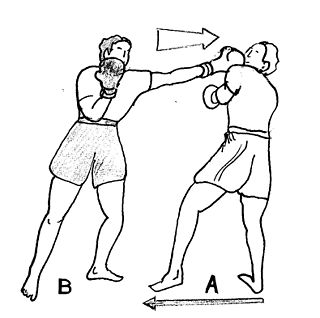
In boxing, the "one-two combo" is the name given to the combination consisting of two common punches found in boxing – a jab followed by the cross. In boxing parlance, fundamental punches are commonly assigned numbers by trainers and in this case there is the jab (#1) and the cross (#2).
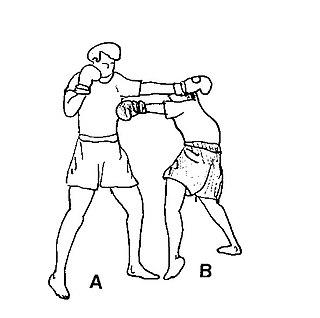
Slipping is a technique used in boxing that is similar to bobbing. It is considered one of the four basic defensive strategies, along with blocking, holding, and clinching. It is performed by moving the head to either side so that the opponent's punches "slip" by the boxer.

The uppercut is a punch used in boxing that starts low and travels upwards vertically aiming at the opponent's chin or upper abdomen. It is, along with the cross, one of the two main punches that count in the statistics as power punches.
Covering in martial arts is the act of protecting against an opponent's strikes by using the arms and shoulders to block and absorb the impact of strikes on the head and torso and prevent injury. Covering is the last line of defense to avoid an incoming strike and consists of putting arms and forearms up and in front of the area on the body that is being blocked. The technique of covering is widely used among martial arts and has a multitude of variations.
Jaron Ennis is an American professional boxer who has held the IBF welterweight title since 2023. As an amateur, he won a silver and gold medal at the U.S. National Golden Gloves Championships in 2014 and 2015 respectively.

Isaac Jonathan Cruz González is a Mexican professional boxer who has held the World Boxing Association (WBA) super lightweight title since March 2024. As of November 2021, Cruz is ranked as the world's sixth-best active lightweight by the Transnational Boxing Rankings Board, eighth by BoxRec, and tenth by The Ring magazine.







